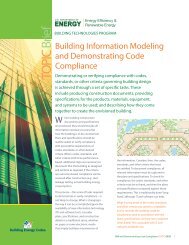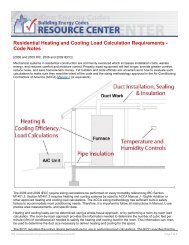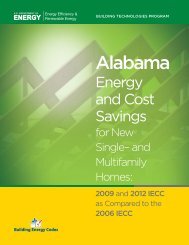Shaping the Energy Efficiency in New Buildings - Building Energy ...
Shaping the Energy Efficiency in New Buildings - Building Energy ...
Shaping the Energy Efficiency in New Buildings - Building Energy ...
Create successful ePaper yourself
Turn your PDF publications into a flip-book with our unique Google optimized e-Paper software.
f) South Korea’s build<strong>in</strong>g energy codes, <strong>the</strong> Build<strong>in</strong>g Design Criteria for <strong>Energy</strong>Sav<strong>in</strong>g (BDCES 2008) and RBFCO 2008, covers three regions: central, south andJeju Island.g) The United States build<strong>in</strong>g energy codes ASHRAE 90.1-2007 and International<strong>Energy</strong> Conservation Code (IECC 2006) cover eight climate zones: 1) very hothumidand dry; 2) hot-humid and dry; 3) warm-humid, dry and mar<strong>in</strong>e; 4) mixedhumid,dry and mar<strong>in</strong>e; 5) cool-humid, dry and mar<strong>in</strong>e; 6) cold-humid and dry; 7)very dry; and 8) subarctic.Generally, build<strong>in</strong>g energy codes <strong>in</strong> APP countries allow variations <strong>in</strong> climate andgeographic conditions and provide relevant <strong>in</strong>formation on <strong>the</strong> def<strong>in</strong>ition andcategorization of <strong>the</strong>ir climate zones and geographic coverage.2 Development HistoryDenmark was among <strong>the</strong> first countries to adopt comprehensive build<strong>in</strong>g energy codes <strong>in</strong>1961, and s<strong>in</strong>ce <strong>the</strong>n it has seen average household energy consumption per unit of spacedrop substantially (Lausten, 2008). Build<strong>in</strong>g energy codes are not new to <strong>the</strong> APP region.The United States was <strong>the</strong> first APP country to adopt a comprehensive build<strong>in</strong>g energycode, followed shortly <strong>the</strong>reafter by Japan and South Korea. As <strong>in</strong>dicated by <strong>the</strong> timel<strong>in</strong>eshown <strong>in</strong> Table 6, <strong>in</strong> <strong>the</strong> past 10-15 years, all APP countries have worked to streng<strong>the</strong>n<strong>the</strong>ir build<strong>in</strong>g energy codes and enforcement systems. As a result, many APP countrieshave seen impressive improvements <strong>in</strong> <strong>the</strong> energy efficiency of new build<strong>in</strong>gs. Currently,several APP countries are consider<strong>in</strong>g even more radical improvements to <strong>the</strong>ir build<strong>in</strong>genergy codes. For example, <strong>the</strong> United States is consider<strong>in</strong>g a 30% improvement <strong>in</strong> <strong>the</strong>requirements for both commercial and residential build<strong>in</strong>gs by 2010 and 2012,respectively. Climate change, energy security and consumer cost reduction are all driversbeh<strong>in</strong>d this trend.The rema<strong>in</strong>der of this section summarizes <strong>the</strong> development of build<strong>in</strong>g energy policy andcodes <strong>in</strong> each APP country.22
















